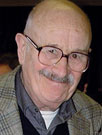Overtaken by events

Winston Churchill had a knack for it, but posterity can play tricks on those seeking to create a defining image. David Bernstein is worried about that 2012 logo
‘A riddle, wrapped in a mystery, inside an enigma.’ Winston Churchill’s 1939 descrip tion of Russia ‘still rings true’, headlines the International Herald Tribune (2/3 August). Churchill had penned a defining image – insightful, resonant and endur – ing. He coined another, for the post-war period: ‘Iron Curtain’.
Defining images collide in a play about one of his success – ors, Harold Macmillan, Never So Good currently at the National Theatre. We see this seemingly all-powerful leader fade before the reality of US Secretary of State Dean Acheson’s view of post-war Britain as having lost an empire and not yet found a role.
How good is the advertising business at defining images? We succ eed occasionally at stamping a brand over genera – tions, so it retains a presence long after the advertising has ceased (Guinness/goodness is a classic example). But our attempts to define a brand, company, political party or event for posterity have met with only modest success.
A notable exception is Doyle Dane Bernbach’s Volks wagen campaign, born in 1950s Manhattan. Defining an image is tough enough from scratch, but the task is huge when you need to remove two decades of toxic baggage. Volkswagen equals ‘people’s car’ of the Third Reich. Transforming that into the modest yet confident personality which taught the advantages of thinking small and conveyed the need for, and commercial benefits of, honesty and understatement resulted in an attitude shift matched only by that achieved by the line ‘made in Japan’.
It takes years to define, let alone redefine, an image, plus tenacity, vision and singlemindedness. Most companies lack the resolve: the slightest economic downturn may put the empha sis on short-term returns at the expense of longterm corporate values.
Another hazard is the difficult art of prediction. You hope your image will endure. Abram Games achieved this for the 1951 Festival of Britain, though what the public took to its heart was the iconic Skylon, a beautiful, but meaningless floating ‘silver pencil’.
Most defining images are unplanned, the result, in Macmillan’s words, of ‘events, dear boy, events’. The defining image of our official Millennium celebrations was appropriately awkward: the Queen’s hand – clasp in Auld Lang Syne. At her 1953 coronation the defining image was not the actual ceremony, but the sight during the procession of another queen, Salote of Tonga, braving the rain in the only open carriage.
She had an umbrella and didn’t use it. Steve McClaren had one and did. The sight of him walking the touchline became the defining image of England’s recent, abject exit from European football.
Neville Chamberlain’s umbrella became symbolic – of protection. But the defining image of his tenure as Prime Minister was the piece of paper he brought back from Munich in 1938. It was meant to represent ‘peace in our time’. A year later it repre sented the opposite – ‘a tyrant’s promise’. Similarly, New York’s Twin Towers have served both as a defining image of the city’s assurance and, since 9/11, its vulnerability.
But all of us are vulnerable and, when assurance turns into arrogance, likely suffer hubris.
What is the defining image of Barings? A rogue trader. Of Northern Rock? A queue of anxious customers.
What will be the defining image of the 2012 Olympics? The logo – or something even more unlikely?
-
Post a comment




